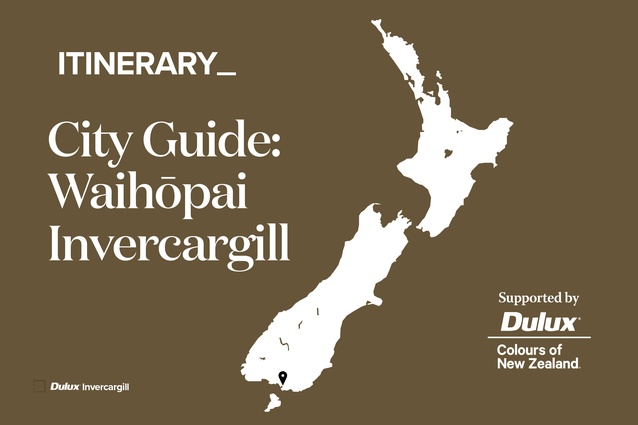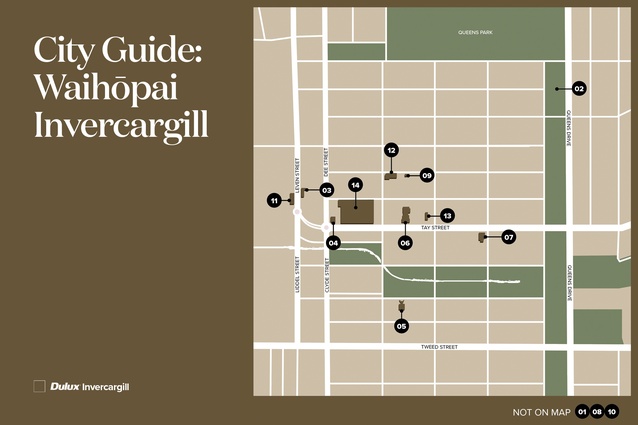Itinerary City Guide: Waihōpai Invercargill
In this Itinerary, supported by Dulux Colours of New Zealand, Andrew Barrie tours 14 resilient buildings in Waihōpai Invercargill and finds a diverse range of architectural styles from Classic Revival, to Modernist.
Our southernmost and westernmost city, Invercargill sits on a river bank at the centre of the fertile Southland Plains. The city’s original coat of arms tells us all we need to know about what underwrote its prosperity; it features a plough, a sheaf of corn, a bale of wool and a ship to carry those goods overseas.
The region was a site of early interaction between Māori and Europeans — notably, whalers and missionaries. Early development in the area centred on the port at Bluff but Invercargill saw a growth spurt following the discovery of gold to the north in Central Otago in the 1860s. A boom in agricultural exports in the 1880s encouraged the growth of farming in the region. The resulting flow of wealth allowed architects, notably Frederick Burwell, to fill the city’s commercial core completely with fine two- and three-storey buildings in various Classical Revival styles. The result was a streetscape with a continuity and coherence that radiates from photos of the era and which can now be experienced by Kiwis only in truncated form in Ōamaru.
The city’s continued confidence was evident even as the 20th century saw newer historicist styles grafted into the Italianate street frontages — the romantic Queen Anne-style Alexandra Buildings (c. 1901) by Burwell’s pupil Cuthbert Brodrick, Edmund Wilson’s Edwardian baroque Town Hall and Theatre (1906), and the monumental, American-influenced First Presbyterian Church by localborn but US-trained John Mair. Mair left Invercargill but continued to play a key role following his appointment as Government Architect in 1923 — his Law Courts (1938) and Post Office (1941) leavening the streetscape with art deco and straight-laced moderne insertions. A new generation of local designers, led by Allan Ford and Edward Smith, emerged in the inter-war period, further stripping back the decoration.
Following visits in the mid- 1960s, the Rolling Stones famously declared Invercargill “the arsehole of the world” but the post-war period was a great time for architecture in the city. As with other provincial centres, Invercargill benefited from the wool boom sparked by the Korean War in the early 1950s. The architectural legacy of that time is an abundance of modernist gems — particularly churches and community facilities — by firms such as Ford, Gray, Derbie and Hurd, Smith, Rice, Lawrence and Mollison, McArthur and Boag, Barham and Barham, Lew Simpson, and Arthur Milne.
As in Dunedin, the local scene is characterised by long-standing lineages that survive to the present day, several of the city’s current firms having roots extending back to the modernist heyday. Agriculture continues to power the region — the dairy factory at Edendale, a short drive from Invercargill, is New Zealand’s longest-running plant and one of the world’s largest — and the Zero Fees Scheme at the Southern Institute of Technology has helped keep the city centre lively. There is a sprinkling of projects by big-city firms but the locals still dominate. The streetscape is now a patchwork of architectural styles spanning back to the 1860s but its architects have, for the most part, continued to obey the cardinal rule of urban design: build to the lot line. There are fears that the huge Invercargill Central development might draw life off the street but the city has a long history of arcade shopping. The city centre is compact but remarkably intact and conjures a surprisingly urbane vibe.
While other provincial centres, such as Whanganui, have a rich presence in our architectural history, Invercargill is notable by its absence. Peter Shaw’s history of New Zealand architecture includes just four of its buildings. Why? Perhaps because, unlike those of nearby Dunedin, Southland-based architects rarely worked elsewhere. The city presents a smorgasbord of great buildings; for almost all, both they and their designers are largely unknown beyond the city. Invercargill reminds us that there are still treasures to be unearthed in our architectural history.
THE ITINERARY
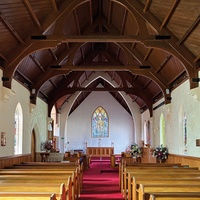
1. 1878 – All Saints Anglican Church
507 Dee Street
Frederick Burwell
Invercargill was founded in 1856 and its first churches were built in timber. In the 1870s, a second wave of church building saw churches constructed in more substantial materials; All Saints was one of the first in the city to be completed. Its designer, Scottishborn Frederick Burwell, who had lived for some years in Queenstown (see Architecture NZ July/Aug 2021), made significant contributions in Invercargill before moving on to work in various Australian cities, including Freemantle. The wooden Parish Hall was completed in 1905 by Burwell’s apprentice, Cuthbert Brodrick (see listing 4). Check out Burwell’s former Bank of New Zealand (1879) on ‘Bank Corner’ at 1 Tay Street.
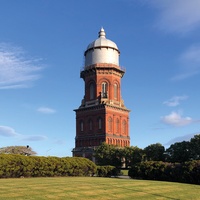
2. 1889 – Water Tower
101 Doon Street
William Sharp, Borough Engineer
An impressive civic device from the Victorian period, the Tower was the very flat city’s primary source of pressurised water supply and, today, still serves as a backup. It was designed by William Sharp, a former Public Works Department engineer. Restoration projects in the late ’80s and again in recent years have respectively restored the façade and improved earthquake resilience. Those interested in displays of brick craftsmanship should also check out the adjacent Water Works Control Building, and the neighbouring scalloped concrete water reservoirs feel like a little bit of Palm Springs modernism. Together, they form a dramatic precinct, showcasing the unity of beauty and utility.

3. 1896 – Victoria Railway Hotel
1-3 Leven Street
McKenzie and Gilbertson
The railway line from Invercargill (see listing 11) was one of the nation’s earliest — so much so that its first rails were wooden. Most centres soon had hotels handy to their stations, and this one was designed by local firm McKenzie and Gilbertson in the Edwardian Free Style; it borrows elements from the Italianate, Queen Anne and Baroque Revival styles. Extended, trimmed and altered over the years, the building has housed a hotel business for nearly a century but is currently closed and facing competition. The Menzies Building (1966) next door, a government departmental building designed by the Ministry of Works, is receiving a radical makeover as a new hotel.
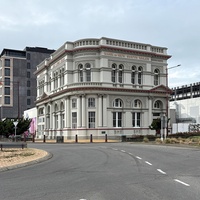
4. 1904 – Bank of New South Wales
Corner Dee and Tay Street
Cuthbert Brodrick
Erected on the site of Invercargill’s very first business premises, this building is a key element of Invercargill’s historic ‘Bank Corner’. The original bank on the site was designed in 1875 by William Clayton (who served as New Zealand’s first Colonial Architect) but severely damaged by fire a few years later. The ornateness of Brodrick’s classical decoration attests to the prosperity generated by the region’s growing agricultural productivity at the start of the century. Brodrick’s interior has been modified but the façade remains relatively unchanged. Brodrick fans might check out the Public Trust Building (1921) at 28 Don Street, produced during his partnership with Thomas Royds.
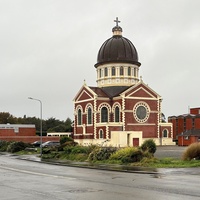
5. 1905 – St Mary’s Basilica
79 Tyne Street
Francis Petre
One of New Zealand’s great ecclesiological architects, Francis Petre is best known for his Catholic cathedrals in Dunedin, Wellington and Christchurch, the latter being demolished after the earthquakes. A key element on the Invercargill skyline, the taller-than-wide structure is a condensed Greek Cross, topped by a copper-sheathed dome. The 37m-high interior was dealt with in a playful but precise manner, with creamcoloured arched windows, quoins and cornices, and a beautiful stained-glass angel. The modernist neighbours are beauts: McArthur & Boag’s Catholic Presbytery (1964) to the west, and Smith, Rice, Lawrence and Mollison’s now disused St Catherine’s Convent (c. 1966) to the east.
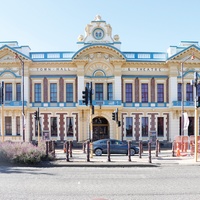
6. 1906 – Town Hall and Civic Theatre
88 Tay Street
Edmund Wilson
Designed with Edwardian baroque gusto by prominent Southland architect Edmund Wilson, the Town Hall and Theatre combined municipal offices, council chambers and a theatre. The complex was officially reopened in 1930 to mark the proclamation of Invercargill as a city. Refurbishments of the complex in the 1980s and the 2000s have ensured it remains a state-of-the-art performing arts venue. The surrounding area is also worth exploring — take a look at the neighbouring St John’s Anglican Church and hall complex, also designed (in part) by Wilson, or take shade under the huge elm, ash, beech and oak trees planted in the 1870s.
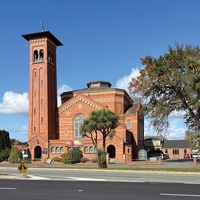
7. 1915 – First Presbyterian Church
155 Tay Street
John Mair
Now a Category 1 historic place, this was Invercargill local John Mair’s first building. Training under William Sharp (listing 2) and at the New Zealand Railways under George Troup, he later studied in the US and then spent time working in New York and travelling to London. In his history of New Zealand architecture, Peter Shaw wrote: “Such an eclectic mixture of Italian Romanesque and Byzantine elements might have been fashionable in Boston of Philadelphia… In Invercargill, however, it was considered questionable by a congregation more familiar with Gothic church architecture.” Mair would go on to lead the Public Works Department and, eventually, be appointed Government Architect.
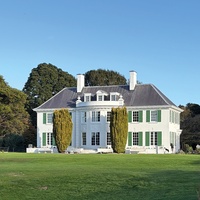
8. 1924 — Anderson Park
91 McIvor Road
Cecil Wood
This house and its leafy grounds were developed by Sir Robert Anderson, a local business mogul and, in his later years, philanthropist (Anderson gifted this estate to the city). The elegant neo-Georgian homestead was designed by Cecil Wood, the most prominent Canterbury architect of the period, and now serves as a public art gallery. The grounds are home to Te Wharepuni o Anehana, its carvings produced by Rotorua tohunga whakairo Tene Waitere (Ngāti Tarāwhai). On the drive out, pop by St Stephen’s Church Centre (1967) at 284 North Road by local modernists Smith, Rice, Lawrence and Mollison. See Home & Building August 1967.
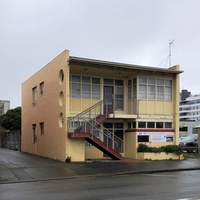
9. 1956 – Don Street Medical Centre
69 Don Street
Barham and Barham
These consulting rooms were designed by Monica Barham, who was the first woman registered architect in the Southland and Otago Branch of the NZIA, and who worked in a prolific partnership with her husband Cecil. Barham’s profile has been raised in recent years through the scholarship of Megan Rule, and this project was recently the winner of an NZIA Enduring Architecture Award (see Architecture NZ Sept/Oct 2023), now standing as New Zealand’s earliest female-designed, award-winning building. See Architecture NZ May/ June 2024. Barham and Barham employed many of the same modernist motifs in their Methodist Church (1958) at 56 Foyle Street, Bluff.
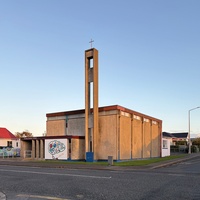
10. 1967 – Georgetown Baptist Church
51 Centre Street
Lew Simpson
One of New Zealand’s underappreciated architectural gems, this ruthlessly abstract concrete box looks more like a transformer station or telephone exchange than a church. The interior is a disciplined synthesis of light, structure and material — Michael Findlay wrote that “the play of coloured light on the building’s interior [is] architecture at its most simple and moving”. The church earned Simpson one of two NZIA National Awards he received in 1967 (the other was for a nearby house) and he would go on to make numerous contributions to the city. Stop by his The Cheeky Llama Cafe (1968) in Queens Park, which also survives in near original condition.
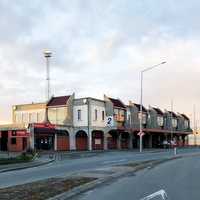
11. 1978 – Invercargill Railway Station
Leven Street
Ford, Gray, Derbie and Hurd
In 1920, following Great War service that included the battle of Passchendaele, Allan Ford began one of the great lineages in Invercargill architecture. He started solo and his firm evolved into Ford, Gray, Derbie and Hurd, then Baxter Hesselin McDowell Architects (listing 12) and, now, Beattie McDowell Architects. Ford was also the father of Monica Barham (see listing 9). Prompted by the 1863 Wakatipu gold rush, the line from Invercargill was just the second steam railway in the nation but passenger trains stopped running to Invercargill in 2002. This building is now looking a bit unloved but it retains its ’70s swagger. See NZIA Journal April 1975.
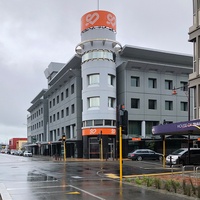
12. 1993 – SBS Bank Head Office
51 Don Street
Barclay Architects and Baxter Hesselin McDowell Architects
The Southland Building Society traces its origins back to 1869 when it was founded by James Bain, a Southland pioneer who had walked the 200km journey from Dunedin to Invercargill. It has passed through various iterations and is now a fullservice bank still headquartered in Invercargill. Understandably, the project sought “to bridge traditional and contemporary symbols”. The project might be the world’s southernmost example of PoMo whimsy but it deals earnestly with all the urban fundamentals: extra height to emphasise the corner, articulated volumes to mitigate scale, and active frontages at street level. See Architecture NZ May/June 1993.
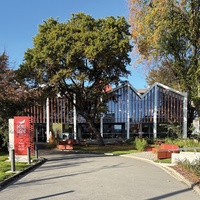
13. 2021 – Te Rau o Te Huia SIT Centre for Creative Industries
108 Tay Street
McCulloch Architects
Supporting fees-free study at the Southland Institute of Technology has been a key part of local efforts to revitalise the city, reinforcing the liveliness provided by SIT’s campus in the centre of the city. In 2018, SIT acquired the historic St John’s Church adjacent to the campus. The church complex had been developed by a succession of key local designers, including McKenzie and Gilbertson, Edmund Wilson (see listing 6) and Smith, Rice, Lawrence and Mollison. Work by McCulloch Architects, another local firm, involved strengthening, upgrades and additions to create an integrated facility for SIT’s programmes for animation, art, design, fashion, film and music.
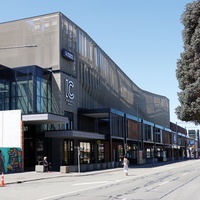
14. 2022 – Invercargill Central
67 Esk Street
The Buchan Group
Invercargill’s central city feels remarkably intact, with mercifully few of the papered-up shop windows or car-park-where-a-buildingused- to-be ellipses that mar the downtowns of many of our smaller cities. In fact, things appear to be on the up. This shopping mall involved the redevelopment of almost an entire central city block. The project required the demolition of 43 buildings, many of them historic but including some that were under-occupied and many that were earthquake-prone. Heritage values have been served by the retention of notable historic façades on Esk Street, and the shared space down this frontage feels very urbane.
OTHER ADDRESSES
Former Masonic Hall (1864)
32 Kelvin Street
Taylor & Marchant
Alexandra Buildings (c. 1901)
83 Dee Street
Cuthbert Brodrick
David Strang (WEA) Building (1912)
100 Esk Street
Richard Marshall
Former Grand Hotel (1913)
76 Dee Street
Cuthbert Brodrick
Southland Boys’ High School (1926)
181 Herbert Street
John Mair, Government Architect
Former Masonic Hall (1926)
80 Forth Street
Brodrick & Royd
Law Courts (1938)
35 Don Street
John Mair, Government Architect
St Theresa of Lisieux Church (1956)
40 Perth Street
Ted McCoy
Scottish Hall (1957)
112 Esk Street
Smith and Rice
Kelvin Hotel (1964)
20 Kelvin Street
Arthur Milne
Don Street Redevelopment (2017)
20 Don Street
McCulloch Architects
Invercargill Estuary Walkway Shelters (2017)
Access from Bond Street
Beattie McDowell Architects
Invercargill Public Library (2019, refurbished)
50 Dee Street
Beattie McDowell Architects
The Langlands (2022)
59 Dee Street
Warren and Mahoney
SOURCES
The first source to seek out is Michael Findlay’s ‘The built environment’ in Paul Sorrell’s Murihiku: The Southland Story (Invercargill: Southland to 2006 Book Project Committee, 2006). The best source on practice in the region is architect Norman Ledgerwood’s fantastic Southern Architects: A History of the Southern Branch of the New Zealand Institute of Architects (Dunedin: Southern Branch of the NZIA, 2009). Ledgerwood’s work aside, Invercargill’s footprint in the literature is — like many other out-of-the-way provincial centres — remarkably small. There are just four buildings (St Mary’s, Town Hall, First Presbyterian and Anderson Park) in Peter Shaw’s History of New Zealand Architecture (Auckland: Hodder & Stoughton, 1991) and just one (Georgetown Baptist) in Julia Gatley’s Long Live the Modern: New Zealand’s New Architecture, 1904–1984 (Auckland: Auckland University Press, 2008). When looking further back, useful sources are Frances Porter’s Historic Buildings of New Zealand — South Island (Auckland: Methuen, 1983) and the New Zealand Historic Places Trust’s Historic Building of Otago and Southland of 1989.

The Itinerary series is supported by Dulux Colours of New Zealand. Dulux Colour Specialist Davina Harper has selected a Colours of New Zealand palette based on this itinerary. See the full range and order colour samples here.

